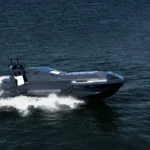At AUSA 2025 in Washington D.C., General Atomics Aeronautical Systems Inc. (GA-ASI) revealed a new Short Takeoff and Landing (STOL) variant of its MQ-1C Gray Eagle drone. Designed to support expeditionary operations from naval vessels and unprepared airstrips, the Gray Eagle STOL aims to fill a critical gap between large fixed-wing Group 4/5 UAVs and vertical takeoff platforms.
Gray Eagle STOL: Bridging Fixed-Wing Endurance with Tactical Flexibility
The Gray Eagle STOL is an evolution of the MQ-1C Extended Range (ER) platform but incorporates substantial airframe modifications to enable takeoffs and landings on short or improvised runways. GA-ASI has not disclosed exact runway length requirements but claims it can operate from “roughly one-third” the distance needed by legacy Gray Eagles—potentially under 300 meters depending on payload.
Key enhancements include:
- High-lift wing design with double-slotted flaps
- Reinforced landing gear for rough terrain
- Tailhook option for arrestor gear compatibility on naval vessels
- Automated takeoff/landing system optimized for confined spaces
- Retractable sensor turret to reduce ground clearance requirements
The STOL variant retains the core ISR capabilities of the MQ-1C ER—including EO/IR sensors, synthetic aperture radar (SAR), signals intelligence (SIGINT) payloads, and up to four AGM-114 Hellfire-class munitions. It also supports Link-16 integration for joint-force interoperability.
Expeditionary ISR from Littoral Ships and Remote Terrain
The U.S. Army’s Future Vertical Lift Cross-Functional Team (FVL CFT) has emphasized the need for Group 4/5 UAVs that can deploy without fixed infrastructure—a key requirement in Indo-Pacific scenarios where long runways are scarce or vulnerable. The Gray Eagle STOL directly addresses this by enabling launch/recovery from:
- Austere forward operating bases with dirt or gravel strips
- Expeditionary Advanced Bases (EABs) with minimal logistics footprint
- Littoral Combat Ships (LCS), amphibious vessels, or even modified commercial ships using arrestor gear
- NATO road networks or highways in contested environments
This capability complements existing VTOL drones like the V-BAT or ALTIUS but offers significantly greater endurance—upwards of 40 hours—and heavier payload capacity (~360 kg). It also provides redundancy against anti-access/area denial (A2/AD) threats that may target traditional airbases.
Program Status and Testing Roadmap
The Gray Eagle STOL is currently in advanced prototype stage. According to GA-ASI officials at AUSA, flight testing began in mid-2025 at Dugway Proving Ground with both dirt strip trials and simulated carrier deck operations using arrestor systems.
The U.S. Army has not yet issued a formal acquisition program of record but is evaluating the platform under its Future Tactical Unmanned Aircraft System (FTUAS) Increment III framework as a potential complement—not replacement—for rotary-wing-launched drones.
If successful, initial operational capability could be achieved by FY2027 depending on funding prioritization within Army Aviation modernization plans.
Comparison to Other STOL and VTOL Platforms
The Gray Eagle STOL enters a competitive field of tactical UAVs seeking expeditionary relevance:
- V-BAT: Vertical takeoff tail-sitter drone used by SOCOM; limited endurance (~8–10 hrs)
- AeroVironment Jump20: Hybrid VTOL fixed-wing with ~14-hour endurance; selected under FTUAS Inc I
- Puma LE & Arcturus JUMP: Smaller Group III-class systems with lower payload/range profiles
- Boeing MQ-25 Stingray: Carrier-based refueling UAV; larger strategic role but Navy-only focus
The Gray Eagle STOL offers a unique middle ground—retaining Group IV range/endurance while gaining near-VTOL basing flexibility without rotor complexity or reduced loiter time.
Tactical Implications for Multi-Domain Operations
If fielded widely, the Gray Eagle STOL could transform how Army aviation supports distributed operations across multiple domains. Potential use cases include:
- Sustained ISR coverage over island chains without local airfields
- Cueing long-range fires via sensor-to-shooter links in denied environments
- SIGINT collection near adversary coastlines without risking manned aircraft
- Munitions delivery against high-value targets during early-phase conflict entry ops
This aligns with Joint All-Domain Command & Control (JADC2) initiatives aiming for resilient C4ISR across dispersed nodes. The drone’s ability to integrate into shipboard command networks further enhances its utility in joint maritime campaigns.










